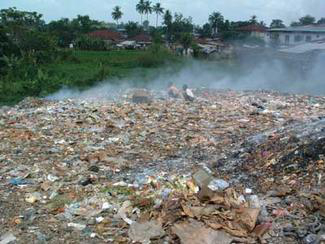Open Dumps...A Thing of the Past. Landfills vs Open Dumps, part 1
by: Leslie Jones
When you think of a landfill, does it conjure up an image of a big hole in the ground with trash in it that gets covered with dirt every once in a while? Studies show that when asked what a landfill is, this is a close depiction of several answers given. In reality, Federal guidelines have made modern landfills an intricate layering system that puts “open dumps” to shame and will keep them a thing of the past.
An open dump refers to a land disposal site where solid waste is disposed of in a manner that does not protect the environment, is susceptible to open burning, and is exposed to the elements, vectors, and scavengers. 
Throughout history dumps have been used to solve solid waste problems. In the past, open dumping was used as an inexpensive and often appropriate solution. It served the purpose of keeping waste separated from commercial and residential areas thus limiting exposure to disease and objectionable odors. However, the introduction of more complex products into the waste stream, increased urbanization and population growth, have all resulted in a huge increase in the negative impacts of open dumps.
Today the use of open dumps does not conform to the increasing public awareness of environmental issues, including the current focus on sustainability and global climate change. Closing, or alternatively upgrading, open dumps is therefore a key issue for many communities. Upgrading these dumps is an essential step in reducing future environmental and public health impacts, as well as avoiding future costs caused by the ongoing mismanagement of waste, that is now so evident at open dumps.
The visual characteristics of such sites are typically:
-
Widely dispersed uncovered waste
-
Open fires and/or waste periodically on fire
-
No recording or inspection of incoming waste
-
No control of waste placement
-
No compaction of waste
-
No application of cover soil, or minimal cover (often associated only with forming access roads)
-
Scavenging at site
-
No security
-
Vermin, dogs, birds and other vectors often present
-
Poor or no leachate management
-
No provision for the management of landfill gas.
In addition, it is typical for no planning or engineering measures (such as a liner system) to have been implemented prior to the dumping of waste.
The most important potential impacts of open dumping on the environment are public health and safety, environmental impacts, problems encountered in closing open dumps with respect to methods and cost.
There are three principle methods to close an open dump:
-
Covering the waste (in-place closure)
-
Removing the waste from the site
-
Closing by upgrading the dump to a controlled dumping site or sanitary landfill
Most of these small and unsanitary dumps have been replaced by large, modern facilities that are designed, operated, and monitored according to strict federal and state regulations. Today’s landfills eliminate the harmful and undesirable characteristics of dumps to help protect public health and the environment. In addition to being safer for the environment and neighboring communities, these larger landfills hold more trash than the dumps of the past. This greater capacity is necessary to keep up with the steady growth of Municipal Solid Waste (MSW). For more information on trash and recycling options, visit our website at www.wasteawaygroup.com
epa.gov
fedcenter.gov
wastemanagementworld.com